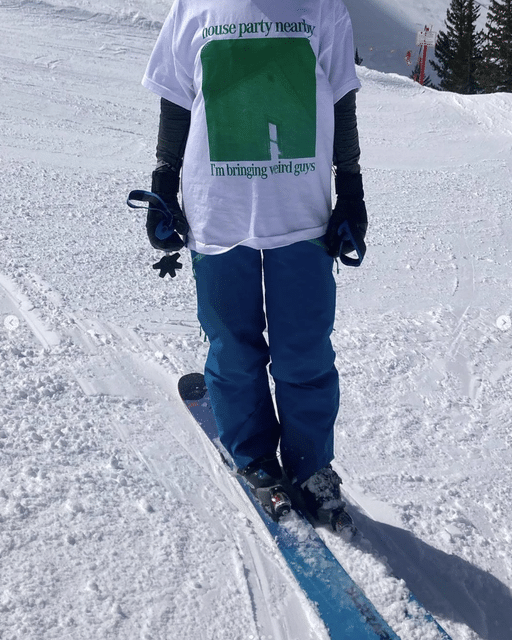Image: Fellers back in the day sporting some 2016 looks. (Image courtesy of Luca Hagmayer)
Newschoolers, I think it’s time we had a conversation about the word “core.” Before you grab the pitchforks, I know saying “core” isn’t cool anymore. The forums have thoroughly beaten the poor word to death, reducing it to a pathetic, memed-out version of its former self. But, despite its demise, I think debating “core” remains relevant to discussions of authenticity and brand involvement in skiing. So, before we bid our final farewells to calling 189 centimeter Vishnu’s “core,” let me take one last crack at the subject.
I first brushed up against the concept of “core” long before people on the forums here at NS were making jokes about Jetskis. I was in my early teens, skiing for the joy of it but also skiing because I wasn’t great at anything else.
It was during this time that I stumbled across Yoke Collection. The rail wizardry, unique designs, and creative videos quickly pulled me in. While I wasn’t remotely familiar with hitting rails, as my home mountain didn’t have a park, Ian Compton quickly became one of my favorite skiers. His outerwear, videos, and trick selection were all on point. In watching Yoke and The Weak videos, I oscillated between looking up to him and wanting to be him. And when I realized that I could own a little piece of the coolness that Compton and the rest of the Yoke team oozed, I was sold.
My first Yoke Collection purchase was a fuzzy brown five-panel. Later, I bought a t-shirt that became a consistent wardrobe staple for several years. Being the proud owner of a piece from a stylish, lesser-known brand offered a unique high. Whenever I wore my Yoke hat, I felt like I was part of a secret club. In retrospect, it’s clear to me that this pull had something to do with the meaning of a “core.”

Image: Core?
Here’s my semi-educated guess at a definition: “core” is effortlessly stylish, not remotely corporate -- a pure commitment to skiing and underground ski culture. It’s a way of dressing, a way of acting, and a way of skiing. It’s cool and exclusive, an indicator of in-group understanding.
Let’s run through some examples to round this out. Jibbing a bench while drinking Fourlokos, probably core. Only skiing under the chairlift, maybe not. Wearing Arsenic and lip on blind twoing every rail in the park? Next question.
Jokes aside, these examples highlight a fundamental point. “Core” is endlessly debatable and unique to specific subcultures. If you asked me what surfers think is “core,” I’d be at a loss. Dumping foamies? Ripping barrel? Shitting on Von Zipper? I have no idea.
“Core” isn’t permanent, either. In the late 2000s and early 2010s, Saga was the brand for serious park skiers. To wear Saga was to indicate that you knew what was up. I remember being jealous of my brother's camo Saga pants and triple XL red Anomie jacket back in the day. Now, the kids are more stoked on windbreakers, techy gear, and darker colors. As time passes, what’s considered “core” changes.
At the start of William Gibson’s novel Zero History, a character named Milgrim is searching for a pair of pants. This isn’t your average pair of pants, though. They’re a pair of rare vintage army BDUs with the perfect cut and proportions. Milgirm’s employer is Hubertus Bigend, the boss of a viral advertising agency called Blue Ant. Bigend aims to sniff out streetwear trends before they hit the mainstream, and those rare pants are his holy grail. While Gibson never uses the word “core” in Zero History, it’s clear what he’s getting at -- if a corporation can reproduce the elements of “core,” they could be in for a big payday.

Image: Carter wearing Full Tilts without a walk mode to tour, he gets it.
Take my experience with Yoke. I was a teenager, I wasn’t particularly secure in my skiing, and I wanted to fit in somewhere that felt exclusive. In purchasing a Yoke piece, I seemed to quell these concerns and desires in one swoop. Yoke was not a brand hellbent on profiteering off “core” appeal, and nothing about their brand was fabricated. They were just a couple of dudes passionate about skiing and making clothes. However, I was ultimately sold on their products because they seemed “core” to a younger, pimply version of myself (side note, Yoke Collection, if you’re reading this, please start making hats again. Adult me is still interested.).
The problem is, simulating “core” when you’re a multi-million-dollar brand isn’t easy. If the North Face tried to pretend they were a few fried 20-year-olds in a basement sewing jackets up, people would understandably lose their minds.
More prominent ski brands have some techniques to weasel their way into the scene, though. Hosting rail jams has proved to be an effective way to garner favor with a “core” audience, as has sponsoring a unique team of athletes. Limited brand collaborations can effectively certify the exclusive nature of gear, too.
These are all business decisions. Locking down “core” skiers can pay dividends -- you get the best riders using your gear, and their stoke can bleed into a broader, more profitable audience. Corporate brands are acutely aware of this fact.

Image: Full Saga kit
Important note -- freeskiing, in comparison to other business sectors, seems significantly less predatory. I’m all for Gilson throwing free rail jams, even if they’re doing so to up their “core” appeal. The same rule applies to ON3P; having a stacked team is symbiotic, not exploitative. The brand boosts its status, and its riders get free gear. The lynchpin here is intent. Is a brand trying to take away from skiing and make a quick buck? Or are they actively contributing to the culture of the sport? If this is one of your metrics when making a purchase, well, then you might just be ‘core’ yourself.
Ultimately, the phrase “core” might be on its way out, hugged to death by NS during the snowless summer months. However, the concept it describes is not. Skiing has always been powered by a thriving underground scene whose influence echoes into the upper echelons of the sport. “Core” is just a new word to describe an old phenomenon, as beholden to the march of time as the illusive concept it addresses. When calling things “core” fully fades away, another new and exciting term will emerge as a replacement, and long may that continue.


Comments